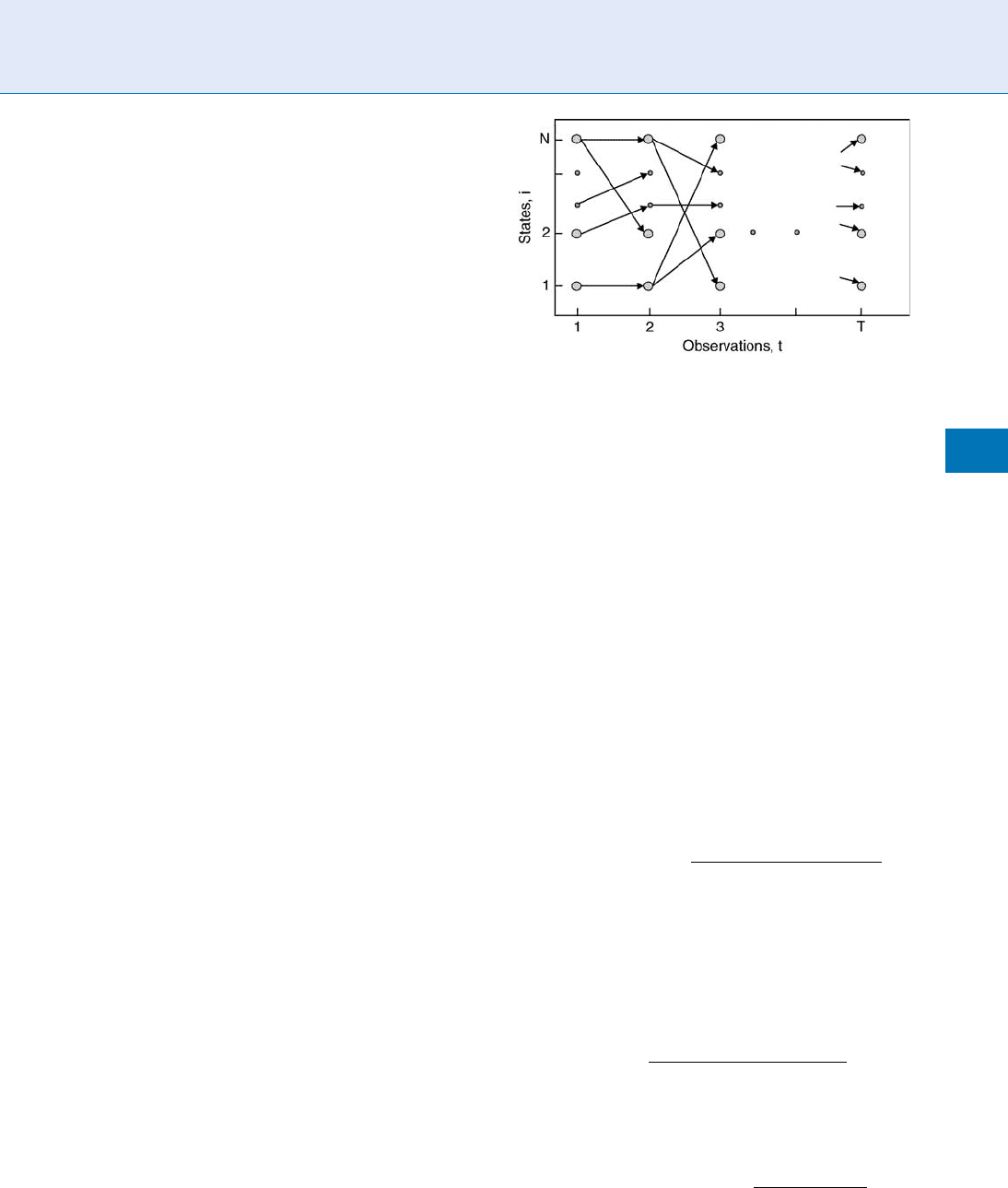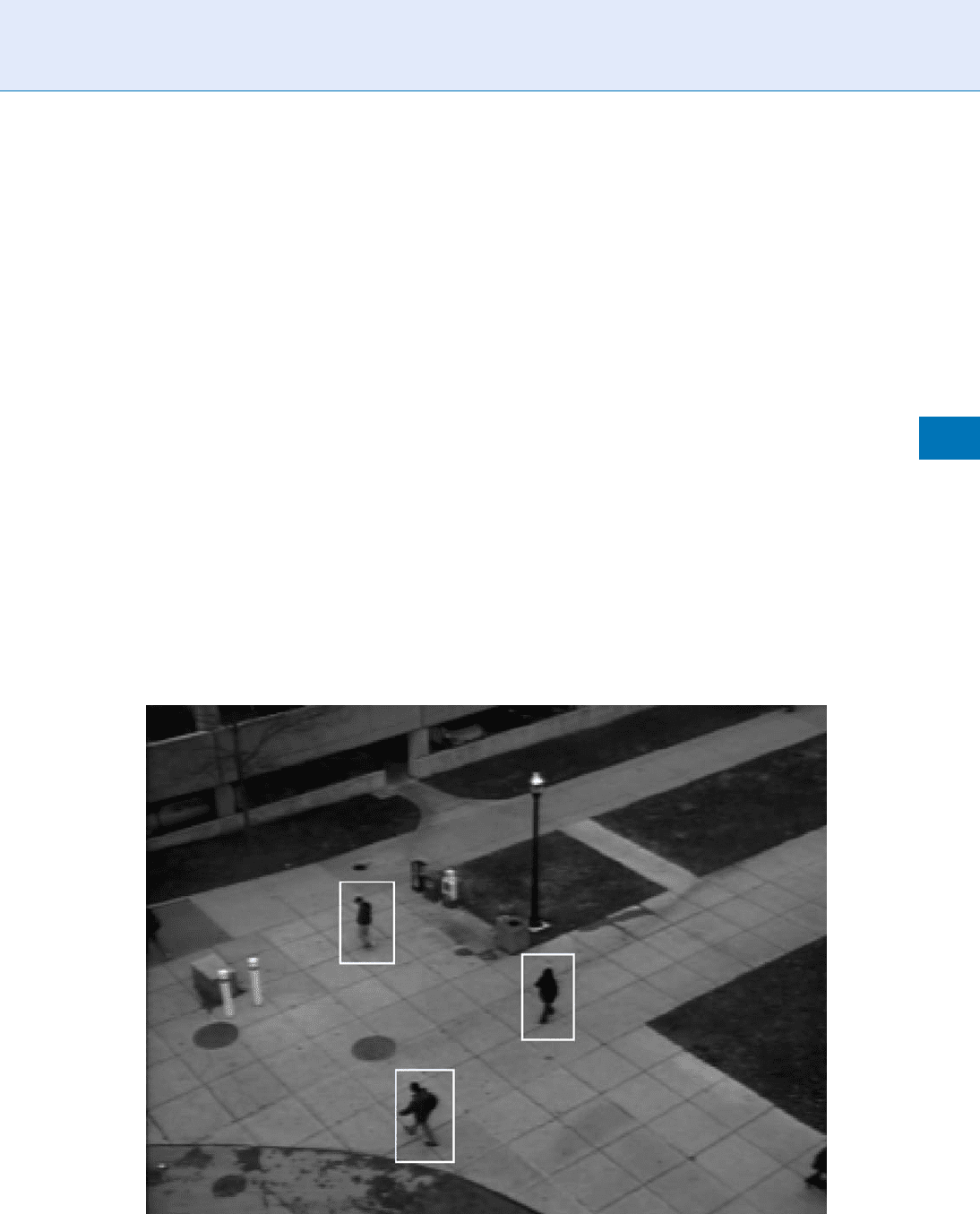Li S.Z., Jain A.K. (eds.) Encyclopedia of Biometrics
Подождите немного. Документ загружается.


Heterogeneous Face Biometrics
STAN Z. LI
Biometrics and Security Research & National
Laboratory of Pattern Recognition Institute of
Automation, Chinese Academy of Sciences, Beijing,
China
Synonyms
Cross-modality face biometrics; Heterogenous face
image matching
Definition
Face images can be captured in different spectral
bands, e.g., Visual (VIS), near infrared (NIR), or
thermal infrared (TIR), or as measurements of 3D
facial shape. These different image types, due to differ-
ent image formation characteristics , are said to be
▶ heterogeneous. More generally, even within the VIS
type, the face images can come from different image
sensors, such as charge coupled device (CCD) and
complementary metal oxide semiconductor (CMOS)
cameras, photo scans, face sketches, under different
illumination conditions, with different image resolu-
tions and different image quality. These are heteroge-
neities in the broad sense. Although heterogeneous
face images of a given person differ by pixel values,
the identity of the face should be classified as the same.
The processing and matching of these diverse face
images is collectively referred to as
▶ heterogeneous
face biometrics (HFBs).
Introduction
Different types of face biometrics have been developed,
including visual (VIS) (see a survey in [1]), near infra-
red (NIR) [2], thermal infrared (TIR) [3], and 3D [4]
image based. In each case, it is assumed that both the
enrollment and query face images are of the same type.
This assumption results in the homogeneous processing
and matching of face images. Two different image
types are said to be heterogeneous if they have different
image formation characteristics. Although heteroge-
neous face images of a given person may
differ significantly by pixel values, the identity of the
face should be classified as the same notwithstanding
the source, illumination, and quality of the image. The
processing and matching of these diverse face images
is collectively referred to as heterogeneous face
biometrics (HFBs).
HFBs provide engines and systems for matching
across different imaging systems, either in different
spectral bands or modalities. These are considered
HFBs (in the true sense). These involve comparison of
face images between VIS, NIR, TIR, and 3D face
images. Heterogeneities in the same type of imaging
system are, in the broad sense, such as variations dealt
with by the conventional VIS face recognition, includ-
ing photo scans and face sketches. Arguably, the true
sense HFBs are more challenging than the broad sense
HFBs of VIS-VIS, NIR-NIR, and 3D-3D comparisons,
because the former contain more heterogeneous fac-
tors and larger variations than the latter.
Recent developments have led to several proposals
of HFBs that include matching between VIS and face
sketch [5], VIS and NIR [6], and 3D and NIR [7], and
also the reconstruction of the facial shape from an NIR
image [8]. The MBGC (Multiple Biometric Grand
Challenge) tests organized by NIST (National Institute
of Standards and Technology) has devised the scenario
of matching between VIS and NIR face images as one of
its experiments [9], with the purpose of examining the
feasibility of NIR-VIS face matching and determining
how its fusion with VIS-VIS face biometric could im-
prove the overall performance. In the following sec-
tions, the heterogeneities encountered in HFBs are
discussed and related research issues are identified.
Heterogeneities in Face Recognition
Images used in face recognition are related to facial
shape, skin, and hair. A 3D face image is related to the
shape only. It is captured by a range-measuring system
usually made from a laser range system or stereo vision
system. Represent a range image taken from a view-
point by z(x, y). The pixel values measure the distances
of the sensor to the facial surface points.
In developing face biometric engines and systems
using spectral images, researchers and engineers have
identified intrinsic and extrinsic factors that affect face
recognition. The
▶ Lambertian law provides an image
formation model, relating a spectral image with the 3D
700
H
Heterogeneous Face Biometrics

shape of the sensed object, the object surface proper-
ties, and the illumination source:
Iðx; yÞ¼rðx; yÞnðx; yÞs ð1Þ
where I(x, y) is the spectral image, r(x,y)isthealbedo
of the facial surface material at point (x, y) (also a func-
tion of the illumination wa velength), n ¼ (n
x
, n
y
,n
z
)
is the surface normal (a unit row vector) at the 3D
surface point z(x, y), and s¼(s
x
, s
y
, s
z
) is the point
lighting direction (a column vector, with magnitude).
The normal directions n(x, y) may be derived from the
range image z(x, y), but not vice versa.
In developing face biometric engines and systems
using spectral images, researchers and engineers have
identified intrinsic and extrinsic factors that affect face
recognition. The facial albedo and the surface shape are
intrinsic factors pertinent to the face identity. These
should be the most important information to be used
for face recognition. On the other hand, extrinsic factors
include illumination, facial ware, hairstyle, expression,
and posture. Since they are irrelevant to the identity of
the face, their influence on face recognition should be
mitigated. Much research and development effort has
been spent to minimize the impact of extrinsic factors,
but the problems still persist and are difficult to solve [1].
Heterogeneous spectral face images have different
albedos, and hence, encode intrinsic factors in different
ways even if extrinsic factors are not accounted for.
Set aside extrinsic factors and focus on the intrinsic
ones. Given a still, frontal face under a fixed illumina-
tion, heterogeneous image formation processes produce
face images of different image configurations of pixel
values. The pixel values have different properties and
interrelationships across heterogeneous face images.
While the above heterogeneities in HFBs are con-
sidered in the true sense, HFBs in the broad sense deals
with heterogeneities in homogeneous face images cap-
tured under heterogeneous conditions. The VIS type of
face images, for example, can be captured
under different illumination conditions,
by different types of image sensors, such as CCD
and CMOS, or sensor brands,
in different image resolutions,
in different image quality, and
by photo scanning or face sketching,
These cause heterogeneities in image formation and
pixel configuration. Among these, face sketches may
have different image styles and contain more
heterogeneities. Also, heterogeneities due to image
resolutions and different image quality also count.
Quality control by imposing constraints on image ac-
quisition conditions is thus sug gested, for example, in
the ISO/ICAO (International Organization for Stan-
dardization/International Civil Aviation Organization)
standard [10].
Research Issues
Despite the heterogeneities, it is desired to perform
face biometric identification and verification with
whatever types of face images available. Research pro-
blems in HFBs include the following:
Understanding heterogeneous image formation
models: This provides a physical basis for modeling
properties of heterogeneous face images.
Discovering relationships between heterogeneous
images: Relations or correlations between hetero-
geneous images of faces or sets of features derived
thereafter may be discovered using heterogeneous
image formation models.
Formulating transformation of one ty pe to ano-
ther: With latent correlations discovered, one
could construct a transformation or mapping
from one type to another.
Extracting common features: Discovered latent
correlations could also be used for extracting com-
mon features for characte rizing face identities in
heterogeneous images.
Matching across heterogeneous images: Matching
algorithms should be developed based on extracted
features that associate heterogeneous face image
properties.
Fusion of heterogeneous information: HFBs can take
advantage of heterogeneous information in face
images and fuse them to improve the performance.
Statistical learning can be used to develop algo-
rithms for solving these problems. For example, for
the recovery of face shape from a single NIR face image
[8], for matching between VIS face and face sketch [5],
VIS face and NIR face [6], and between 3D face and
NIR face [7].
HFBs require the extraction of features common
across heterogeneous types of faces so as to create a
common ground for things to be compared. The ex-
traction of common features is the most distinct issue
Heterogeneous Face Biometrics
H
701
H

among all in HFBs, while the other issues have been
researched in homogeneous face biometrics, and their
results can be applied herein. Methods differ in how
and where to extract the common features – wheth er it
is done at one end of the two types as in the
▶ analysis-
by-synthesis approach, or somewhere in the middle as
in the
▶ common feature approach.
For example, in [6, 7], common features are
extracted using canonical correlation analysis (CCA)
[?] and are in the middle of the two ends rather than at
a single end. In [5], VIS face images (at one end) are
synthesized from face sketches (the other end) explic-
itly, and the matching is performed using features
extracted from the VIS end of face images. Possible
solutions to HFBs can therefore be categorized under
two classes: common feature based and analysis-
by-synthesis based.
Summary
Heterogeneous face biometrics (HFBs) perform bio-
metric matching across heterogeneous face images.
This article has discussed an analysis of problems
in HFBs, identified issues therein, and point out re-
search directions. HFBs could be used as a standalone
module for biometric authentication or work as an
added module to improve face recognition w ith
homogeneous face images. HFBs are not only new
directions for face-based biometrics, but also address
the underlying issues in conventional homogeneous
face biometrics in the broad sense of HFBs. Research
and development of HFBs, with investigation into
problems caused by hete rogeneities in homogeneous
face biometrics, may lead to better solu tions.
Related Entries
▶ 3D Based Face Recognition
▶ Face Recognition, Near-Infrared
▶ Face Recognition, Thermal
▶ Hyperspectral and Multispectral Biometrics
▶ Skin Spectroscopy
References
1. Zhao, W., Chellappa, R., Phillips, P., Rosenfeld, A.: ‘‘Face recog-
nition: A literature survey’’. ACM Computing Surveys 399–458
(2003)
2. Li, S.Z., Chu, R., Liao, S., Zhang., L.: Illumination invariant face
recognition using near-infrared images. IEEE Trans. Pattern
Anal. Mach. Intell. 26 (Special issue on Biometrics: Progress
and Directions), 627–639 (2007)
3. Kong, S.G., Heo, J., Abidi, B., Paik, J., Abidi, M.: Recent advances
in visual and infrared face recognition - A review. Comput. Vis.
Image Underst. 97(1), 103–135 (2005)
4. Bowyer, K.W., Chang, Flynn, P.J.: A survey of 3D and multi-
modal 3d+2d face recognition. In: Proceedings of International
Conference on Pattern Recognition, 358–361 (2004)
5. Tang, X., Wang, X.: Face sketch recognition. IEEE Trans. Circuits
Syst. Video Technol. 14(1), 50–57 (2004)
6. Yi, D., Liu, R., Chu, R., Lei, Z., Li, S.Z.: Face matching between
near infrared and visible light images. In: Proceedings of IAPR
International Conference on Biometric, Seoul, Korea (2007)
7. Yang, W., Yi, D., Lei, Z., Sang, J., Li, S.Z.: 2D-3D face matching
using cca. In: Proceedings of the IEEE International Conference
on Automatic Face and Gesture Recognition, Amsterdam,
The Netherlands (2008)
8. Lei, Z., Bai, Q., He, R., Li, S.Z.: Face shape recovery from a single
image using cca mapping between tensor spaces. In: Proceedings
of IEEE Computer Society Conference on Computer Vision and
Pattern Recognition (2008)
9. NIST: Multiple Biometric Grand Challenge (MBGC). http://
face.nist.gov/mbgc (2008)
10. ANSI/INCITS/ISO/IEC 19794-5: Information Technology -
Biometric Data Interchange Formats - Part 5: Face Image
Data [S] (2007)
Heterogenous Face Image Matching
▶ Heterogeneous Face Biometrics
Hidden Markov Models
JAVI E R HERNANDO
Technical University of Catalonia, Barcelona, Spain
Synonym
HMM
Definition
A Hidden Markov Model is a twofold stochastic pro-
cess composed by a first-order Markov chain, which is
702
H
Heterogenous Face Image Matching

a finite state machine ruled by state transition prob-
abilities that solely depend on the immediate predeces-
sor, and an associated probabilistic function. In a
regular Markov model, the state is visible to any ob-
server external to the model, whereas in a Hidden
Markov Model (HMM), the state is not observable,
that is, hidden, but each state has associated output
probabilities over the possible observable tokens.
Introduction
Hidden Markov Models (HMMs) [1] were introduced
by L.E. Baum in the late 1960s [2], and since the
mid-1970s [3–5], they have become po pular to model
the statistical variation of the spectral features in
speech recognition research. In the late 1980s, HMMs
were applied to the analysis of DNA and other
biological sequences. Nowadays, they are ubiquitous
in bioinformatics, and in par ticular, in biometrics.
Architecture and Types
An HMM is characterized by the following
components:
A set of N states of a first-order Markov chain
S ={S
i
}, i =1,..., N. Denoting the instants of
time regularly spaced associated with the state tran-
sitions by t =1,2,..., T, the state in time t is
denoted by q
t
.
The set of transition probabilities between the
states. Assuming the first-order Markov chain con-
dition, they can be represented by the matrix
A={a
ij
}, i, j =1,..., N, where
a
ij
¼ Pðq
tþ1
¼ S
j
=q
t
¼ S
i
Þ 1 i; j N
The initial state probability matrix, which will be
denoted by the vector
p
i
¼ Pðq
1
¼ S
i
Þ 1 i N
The output probabilities B ={b
j
(O
t
)}, j ¼ 1, ..., N,
where
b
j
ðO
t
Þ¼Pð O
t
jq
t
¼ S
j
Þ j ¼ 1; ...; N;
b
j
being the probability distribution corresponding
to the state j, assumed to be independent of time,
and O
t
the value of the observati on at instant t,
corresponding to the observation sequence O ={O
t
},
t =1,..., T.
Therefore, the HMM can be represented as
l ¼ (A, B, p). The architecture of a three state
HMM is illustrated in Fig. 1. When any state is reach-
able from any other state, as it is represented in the
figure, the model is called ergodic. However, in text-
dependent speaker recognition, as well as in spe ech
recognition, the models are left-to-right, that is, the
states are only reach able from the state itself of lower
index states.
The probability distributions of the output prob-
abilities are discrete in the so-called Discrete Hidden
Markov Models (DHMM) and continuous in the so-
called Continuous Hidden Markov Models (CHMM).
When the original observation data are continuous,
they must be quantized if the DHMM is preferred.
In the case of speech and speaker recognition, where
the observation data are a sequence of acoustic param-
eter vectors, vector quantization techniques were used
when the computational efficiency and amount were
crucial. However, nowadays CHMMs have become
most popular in speech and speaker recognition.
In the DHMMs, the output probabilities take
values in a finite set of symbols called alphabet
V ={v
k
}, k =1,..., M, M being the alphabet size.
Hence, they can be denoted with the matrix B ={b
j
(k)},
where
b
j
ðkÞ¼Pðv
k
en t jq
t
¼ S
j
Þ;
j ¼ 1; ...; N; k ¼ 1; ...; M:
Hidden Markov Models. Figure 1 Representation
of a Hidden Markov Model.
Hidden Markov Models
H
703
H

In the CHMMs, generally, the output probabilities
take values in multidimensional, continuous space,
and they are modeled by parametric multivariate prob-
ability densit y functions. A Gaussian mixture is the
most used [6, 7], because it can approximate any
probability density functio n with an adequate number
of mixtures. In this case,
b
j
ðO
t
Þ¼
X
M
m¼1
c
jm
@ðO
t
; m
jm
; S
jm
Þ; j ¼ 1; ...; N
that is, a linear combination with weight c
jm
of M ℵ
multivariate Gaussian probability density functions
with mean vector m
jm
and covariance matrix S
jm
.
In both cases, once the numbe r of states and the
permitted transitions between them (topology) and
the parameter tying between states are predefined,
these three main problems must be solved in order to
use HMMs in real applications.
Evaluation
Given the observation sequence O ={O
t
}, t =1,..., T
and a model l =(A, B, p), the evaluation pro-
blem consists in efficiently computing P(O|l), the
probability of the observation sequence, given the
model. This probability can be used to classify obser-
vation sequences in recognition applications.
The brute force solution for this problem is to
enumerate all possible state sequences and calculate
their score directly. For a fixed state sequence
Q ={q
t
}, t =1,..., T and assuming independence
between the observations O
t
, the probability of the
observation sequence O can be written as
PðOjO; lÞ¼
Y
T
t¼1
PðO
t
jq
t
; lÞ
¼ b
q1
ðO
1
Þb
q2
ðO
2
Þb
qT
ðOTÞ:
On the other hand, the probability of the state se-
quence Q can be written as
PðQjlÞ¼a
q1
a
q1q2
a
q2q3
a
qT1qT
:
Finally, the joint probability of both the observation
and a fixed state sequences given the model P( O, Q|l)
is simply the product of the terms shown earlier, and
the probability of the observation sequence given the
model can be obtained summing this product over all
possible state sequences
PðOjlÞ¼
X
q1q2qT
p
q1
b
q1
ðO
1
Þa
q1q2
b
q2
ðO
2
Þ
a
qT1qT
b
qT
ðO
T
Þ:
This procedure has a time complexity of o(2TN
T
),
and therefore it is not tractable in real application,
even for moderate values of N and T. Fortun ately,
there is an alternative recursive procedure called
Forward–Backward [2] that computes this probability
in an efficient way, which is summarized as follows.
The forward variable be a
1
(i) is given by
a
t
ðiÞ¼PðO
1
O
2
O
t
; q
t
¼ S
i
jlÞ:
It is easy to show that it can be computed in the
following inductive way:
1. Initialization a
1
ðiÞ¼p
i
b
i
ðO
1
Þi ¼ 1; ...; N
2. Induction a
tþ1
ðjÞ¼
P
N
i¼1
a
t
ðiÞa
ij
b
j
ðO
tþ1
Þ;t ¼1; ...
T 1;j ¼1;...; N
3. Termination PðOjlÞ¼
P
N
i¼1
a
T
ðiÞ
Theses computations can be organized in the
observations and state lattice as shown in Fig. 2, and
have a time complexity of o(N
2
T), which is acceptable
for real application.
Alternatively, the backward variable
b
t
ðiÞ¼PðO
tþ1
; O
tþ2
; ...; O
T
jq
t
¼ S
i
; lÞ:
It can be computed in the following inductive way:
1. Initialization b
T
ðiÞ¼1; i ¼ 1; ...; N
2. Induction (see ure 3) b
t
ðiÞ¼
P
N
j¼1
a
ij
b
j
ðO
tþ1
Þ
b
tþ1
ðjÞ; t ¼ T 1; T 2; ...; 1 i ¼ 1; ...; N
3. Termination PðOjlÞ¼
P
N
i¼1
p
i
b
i
ðO
1
Þb
1
ðiÞ
Hidden Markov Models. Figure 2 Computation lattice of
the Forward algorithm.
704
H
Hidden Markov Models

Decoding
Given the observation sequence O ={O
t
}, t =1,..., T
and a model l = (A, B, p), the decoding problem
consists in choosing the opitmal state sequence
Q ={q
t
}, t ¼ 1, .... T, which best explains the observa-
tions. The solution of this problem permits to
obtain information about the hidden process and is
also a good and efficient approximation of the evalua-
tion problem.
The most popular criterion is to select the state
sequence that maximizes the conditional probability
Q
¼ arg max
Q
fPðQjO; lg¼arg max
Q
fPðQ; OjlÞg:
Again, the brute force method cannot be tackled, even
for moderate values of N and T, and in this case, it is
replaced by the
▶ Viterbi algorithm, which recursively
solves the problem in an efficient way.
The Viterbi algorithm defines the variables
d
t
ðiÞ¼ max
q1;q2;...;qt
fPðq
1
q
2
q
t
¼ i; O
1
O
2
O
t
jlÞg
and c
t
(j) in order to recursively maximize the con-
ditional probability and to retrieve the corresponding
optimal state sequence respectively. Both of them are
updated by using the following procedure:
1. Initialization: d
t
(i)=p
i
b
i
(O
1
) i =1,..., N c
t
(j)=0
2. Recursion: d
t
ðjÞ¼i ¼ 1; ...; N
max
fd
t1
ðiÞa
ji
Þgb
j
ðO
t
Þ;
t ¼ 2; ...; T; j ¼ 1; ...; NctðjÞ¼i ¼ 1 ...N
agr max
fd
t1
ðiÞa
ij
Þg t ¼ 2; ...; T; j ¼ 1; ...; N
3. Termination: P
¼ i ¼ 1 ...N
agr max
fd
t1
ðiÞa
ji
Þg
4. State sequence backtracking: qt
¼ i ¼ 1 ...N
agr max
ðd
T
ðiÞg q
t
¼ c
tþ1
ðq
tþ1
Þ t ¼ T 1; T 2; ...; 1
In this case also, the lattice structure implements the
computations in an efficient way (see Fig. 3). It is
worth noting that not all the state transitions are con-
sidered, but only the ones that lead to the maximum
probability.
Estimation
Given the observation sequence O ={O
t
}, t =1,..., T,
the estimation problem consists in adjusting the para-
meters of the model l =(A , B, p) so as to maximize the
probability of observation of this sequence, given
the model P(O|l). The solution to this problem per-
mits to develop a method to train self-learning
classifiers.
This is the most challenging of the three problems.
In fact, given a finite sequence of observations, it is not
possible to optimally estimate the model parameters.
However, the model parameters can be chosen to lo-
cally maximize the probability P(O|l) by using the
▶ Baum–Welch algorithm [8], which is summarized
in the following section.
For the DHMM case, the variable
x
t
ði; jÞ¼Pðq
t
¼ S
i
; q
tþ1
¼ S
j
jO; lÞ¼
Pðq
t
¼ S
i
; q
tþ1
¼ S
j
; OjlÞ
PðOjlÞ
;
which is the probability of being in the state S
i
at time
t and in state S
j
at time t + 1, given the model and the
observation sequence. This value can be written in
terms of the forward and backward variables an the
parameter models as
x
t
ði; jÞ¼
a
t
iðÞa
ij
b
j
O
tþ1
ðÞb
tþ1
jðÞ
P
N
i;j¼1
a
t
iðÞa
ij
b
j
O
tþ1
ðÞb
tþ1
jðÞ
The variable
l
t
ðiÞ¼Pðq
t
¼ S
i
jO; lÞ¼
Pðq
t
¼ S
i
; OjlÞ
PðOjlÞ
which is the probability of being in the in the state S
i
at
time t, given the model and the observation sequence,
and can also be written as
Hidden Markov Models. Figure 3 Computation lattice of
the Viterbi algorithm.
Hidden Markov Models
H
705
H

l
t
ðiÞ¼
a
t
iðÞb
t
iðÞ
P
N
i¼1
a
t
iðÞb
t
iðÞ
The sum of x
t
(i, j)overt =1,..., T1 can be inter-
preted as the expected value (over time) of the number
of transitions from the state S
i
to the state S
j
. Further-
more, the sum of g
t
(i)overt =1,..., T is the expected
number of times that state S
i
is visited, the sum of g
t
(i)
over t =1,..., T1 is the expected number of transi-
tions made from the state S
i
, and the sum of g
t
(i)over
t =1,..., T, when the symbol is v
k
observed, is the
expected number of times that the model generates the
symbol v
k
in the state S
i
, Therefore, reasonable re-
estimation formulas for p, A and B are
p
i
¼ l
1
ðiÞ i ¼ 1; ...; N
a
ij
¼
P
T1
t¼1
x
t
i; jðÞ
P
T1
t¼1
g
t
iðÞ
; i; j ¼ 1; ...; N
b
j
ðkÞ¼
P
T
t¼1;Ot¼vk
g
t
jðÞ
P
T
t¼1
g
t
jðÞ
; j ¼ 1; ...N; k ¼ 1; ...M
For the CHMMS, the variable g
t
(j, k) is given by
l
t
ðj; kÞ¼
a
t
jðÞb
t
jðÞ
P
N
j¼1
a
t
jðÞb
t
jðÞ
c
jk
@ O
t
; m
jk
; S
jk
P
M
m¼1
c
jm
@ O
t
; m
jm
; S
jm
which is the probability of being in the state j at time
t with the kth mixture accounting for O
t
. Following the
analogous reasoning done for DHMMS, a reasonable
re-estimation formula for B is (formulas for p and A
are the same)
c
jk
¼
P
T
t¼1
g
t
j; kðÞ
P
T
t¼1
P
M
k¼1
g
t
j; kðÞ
; j ¼ 1; ...N; k ¼ 1; ...M
m
jk
¼
P
T
t¼1
g
t
j; kðÞO
t
P
T
t¼1
P
M
k¼1
g
t
j; kðÞ
; j ¼ 1; ...; N; k ¼ 1; ...; M
S
jk
¼
P
T
t¼1
g
t
ðj; kÞ O
t
m
jk
O
t
m
jk
0
P
T
t¼1
P
M
k¼1
g
t
j; kðÞ
;
j ¼ 1; ...; N ; k ¼ 1; ...; M
where prime denotes vector transpose.
It can be shown that using this re-estimation for-
mulae uniformly converge to Maximum Likelihood
estimation, but they only lead to local maxima and
that, in most applications, the optimization surface is
complex, and hence initialization is an issue.
On the other hand, these formulae can also be
obtained directly by maximizing the Baum auxiliary
function
Qðl; l
0
Þ¼
X
Q
PðQ
j
O; lÞlog PQ
j
O; l
0
ðÞ½
and also they can be interpreted as an implementation
of the Expectation-Modification algorithm [9].
Finally, it is worth noting that this optimiz ation
problem has been solved by conventional gradient
techniques. This approach permits the use of other
optimization criteria like MMI (Maximal Mutual In-
formation) [10]. Furthermore, less formalized algo-
rithms like corrective training [11] have been applied.
Summary
Hidden Markov Models composed by a hidden Mar-
kov chain and an observable associated probabilistic
function have become ubiquitous in biometric in the
recent years. Once the topology has been designed, the
three conventional procedures, which solve the main
problems for the application of the Hidden Markov
Models in the real world, have been discussed in this
paper: the
▶ Forward-Backward algorithm for the
evaluation of the model, the Viterbi algorithm for
the decoding of the optimal sequence of the states,
and the Baum–Welch algo rithm to adjust the model
parameters to the observations.
Related Entries
▶ Biometric Algorithm
▶ Classifier Design
▶ Gaussian Mixture Models
706
H
Hidden Markov Models

▶ Machine-Learning
▶ Probability Distribution
References
1. Rabiner, L.R.: A tutorial on hidden markov models and selected
applications in speech recognition. Proc. IEEE 77, 257–286
(1989)
2. Baum, L.E., Egon, J.A.: An inequality with applications to statis-
tical estimation for probabilistic functions of a markov process
and to a model for ecology. Bull. Am. Meteorol. Soc. 73, 360–363
(1967)
3. Baker, J.K.: The DRAGON system – an overview. IEEE Acoust.
Speech Signal Process. Mag. 23, 24–29 (1975)
4. Bakis, R.: Continuous speech recognition via centisecond acous-
tic states. In: Proceedings of the ASA Meeting (1976)
5. Jelinek, F.: Continuous speech recognition by statistical meth-
ods. Proc. IEEE 64, 532–556 (1976)
6. Rabiner, L.R., Juang, B.H.: An introduction to hidden markov
models. IEEE Acoust. Speech Signal Process. Mag. 3, 4–16 (1986)
7. Juang, B.H., Levinson, S.E., Sondhi, M.M.: Maximum
likelihood estimations for multivariate mixture observations
of markov chains. IEEE Trans. Inf. Technol. 32, 307–309 (1986)
8. Baum, L.E.: An inequality and associated maximization tech-
nique in statistical estimation of probabilistic functions of
markov processes. Inequal. 3, 1–8 (1972)
9. Dempster, A.P., Laird, N.M., Rubin, D.B.: Maximum likelihood
from incomplete data via the EM algorithm. J. R. Stat. Soc. 39,
1–38 (1977)
10. Merialdo, B.: Phonetic recognition using hidden markov models
and maximum mutual information training. In: Proceeding of
the International Conference on Acoustics, Speech and Signal
Processing pp. 111–114 (1988)
11. Bahl, Brown, P.F., de Souza, P.V., Mercer, R.L.: Estimating
hidden markov model parameters so as to maximize speech
recognition accuracy. IEEE Tran Speech Audio Processing
1, 77–83 (1993)
Hill-Climbing Attack
Security attacks based on generating artificial data,
injecting it in the system and after analyzing the out-
put, modify such data, as to improve the output. This
is done recursively till the output is the desired result.
In biometrics this attack can be used to generate a
synthetic sample, by analyzing the matching score
returned by the system.
▶ Tamper-proof Operating System
Histogram Equalization
Histogram equalization is a common technique for
adjusting the pixel intensities of images. In histogram
equalization, a monotonic transformation is applied
to the intensities of the pixels in an image. The
transformations are chosen so that the resulting images
have a standard or specified histogram. This is some-
times performed to enhance the contrast or reduce
the effect of lighting variation on the appearance of
a scene.
▶ Face Variation
▶ Image Pattern Recognition
▶ Illumination Compensation
▶ Pre-Processing
HMM
▶ Hidden Markov Models
Human Computing
Human computing is the merging of mobile commu-
nications and sensing technologies, with the aim of
enabling a per vasive and unobtrusive intelligence in
the surrounding environment supporting the activities
and interactions of the users in a human-centered
manner. Specifically, human-centered interfaces sup-
port detection of subtleties of and changes in the user’s
behavior, and initiate inter actions based on this infor-
mation rather than simply responding to the user’s
commands. Technologies like machine analysis of fa-
cial expressions and affective computing are inherent
human-computing technologies.
▶ Facial Expression Recognition
Human Computing
H
707
H

Human Dental Atlas
Human dental atlas is a model for describing shape
and relative position s of teeth in a fully developed
adult dentition. The model categorizes a complete set
of 32 teeth into 6 different classes according to tooth
shape and position.
▶ Dental Biometrics
Human Detection and Tracking
JAMES W. DAV IS ,VINAY SHARMA,AMBRISH TYAGI,
M
ARK KECK
Ohio State University, Columbus, OH, USA
Synonyms
Association; Correspondence; Localization; Pedestrian
detection; Target detection; Video surveillance
Definition
Human detection and tracking are tasks of computer
vision systems for locating and following people in
video imagery. Human detection is the task of locating
all instances of human beings present in an image, and
it has been most widely accomplished by searching all
locations in the image, at all possible scales, and com-
paring a small area at each location with known tem-
plates or patterns of people. Human tracking is the
process of temporally associating the human detec -
tions within a video sequence to generate persistent
paths, or trajectories, of the people. Human detectio n
and tracking are generally considered the first two
processes in a video surveillance pipeline, and can
feed into higher-level reasoning modules such as ac-
tion recognition and dynamic scene analysis.
Introduction
In relation to large-scale biometric and video surveil-
lance systems, there is an increasing need for persistent,
autonomous sensing of people in video using compu-
ter vision algorithms. Biometric systems can be
employed in close proximity (using fingerprint or iris
scans) or remotely (employing face or gait patterns) to
identify or confirm a person’s identity. Hence knowing
‘‘when’’ and ‘‘where’’ to attempt a remote biometric
signature can greatly aid the task in terms of reliability
and efficiency. Being able to detect and track people
from a distance using video cameras can be used to
reliably cue remote biometric sensors to engage only
when appropriate. Furthermore, the desire for (semi‐ )
autonomous video surveillance necessitates computer
vision systems to detect, track, and analyze the beha-
viors of people in video. For example, a large airport
security system could use compu ter vision systems to
simultaneously monitor multiple video camera feeds
and could present only those camera feeds showing
suspicious activity to security personnel.
Fundamental to the afor ementioned remote bio-
metrics and video surveillance applications is the ability
to automatically detect and track people in video . The
purpose of human detection is to find the location of
every person in each video image, while producing as few
false detections as possible. The most common methods
used for detection are template or pattern matching
algorithms. The detections themselves can be used for a
variety of applications, such as person counting or deter-
mining if a person is located in an area where nobody
should be present. Human tracking is the process which
associates the human detections over time to create a
consistent path trajectory for each person. Tracking sys-
tems typically retain some history of the past detections
and use this information along with the current detection
to match and update the trajectories. The output of the
human detection and tracking systems can be further
used in higher-level reasoning modules such as activity
analysis and rec ognition.
Human Detection
Detection, in general, refers to the task of determining
whether or not an instance of a specific object class
is present in the scene. With the growing emphasis on
biometrics and surveillance, special attention has been
paid to the task of detecting humans in images. Smart
urban surveillance systems are typically designed to
monitor people, both to ensure safety and to recognize
unlawful acts. The success of such sur veillance system s
708
H
Human Dental Atlas

is critically dependent on their ability to first reliably
detect and localize all humans in the scene. The task of
human detection is especially challenging due to the
non‐rigid, articulate nature of the human body.
The typical detection output is a bounding box
surrounding each person in the image (Fig. 1). Most
researchers approach human detection as a pattern
classification problem, where the emphasis is on
learning characteristic appearance features of humans
from specially designed training datasets. These data-
sets generally consist of hundreds of labeled images
containing people (positive examples) and a larger
collection of images not containing people (negative
examples). Often the positive examples included in the
datasets are constrained to specific poses or camera
views such that the varia bility of the human class is
limited to some extent. Within such a training frame-
work, several researchers in human detection focus on
devising the most appropriate set of features that
would encompass the variations exhibited naturally
by humans (e.g., changes in pose, size, appearance,
non‐rigid motion, etc.) and at the same time adequ-
ately differentiate the human class from the rest of the
objects in the scene. Image features such as Haar wave-
lets [1], histograms of oriented gradients [2], and
covariance matrices [3], have shown to provide
promising results.
Research in human detection also focuses on effi-
cient learning algorithms and classification techniques
that provide high detection accuracy with low false
positive rates. For example, the use of AdaBoost to eff-
ectively combine hundreds of weak, computationally
inexpensive classifiers was introduced for human de-
tection in [4]. In [3] a classification scheme w as pro-
posed that takes advantage of the geometry of the
manifold on which the extracted features reside.
Other approaches adopt statistical tools such as field
models for modeling human shape and motion [5]
and support vector machines for human classification
[2]. Certain approaches to human detection also
make explicit use of the structure and
▶ kinematics
of the human body, utilizing some form of human
body model [6]. Such techniques often detect the
human body by its smaller components (arms,
legs, torso) instead of training a classifier for the
whole-body form.
Human Detection and Tracking. Figure 1 Typical human detection output showing the location and scale of people.
Human Detection and Tracking
H
709
H
